Short-Term Load Dispatching Method for a Diversion Hydropower Plant with Multiple Turbines in One Tunnel Using a Two-Stage Model
Abstract
:1. Introduction
2. Two-Stage Model
2.1. Influencing Factors of STLD for the HPMTT Problem
2.1.1. Hydraulic and Electrical Connections of HPMTT
2.1.2. Penstock Head Loss
2.2. Unit On/Off Model
2.2.1. Objective Function
- (1)
- Startup/Shutdown water consumption:where
- (2)
- Number of units:where n and N are the index and number of tunnels; t and T are the index and total dispatch periods; i and Mn are the index and number of units for the tunnel n; is total water consumption of startup/shutdown cost, m3/s; yn,i,t is the on/off state of unit i for tunnel n in period t (on = 1 and off = 0); Wn,i,t,on and Wn,i,t,off are the startup water consumption and shutdown water consumption of unit i for tunnel n in period t, m3; Wn,i,on and Wn,i,off are the startup water consumption and shutdown water consumption of unit i for tunnel n, with a given value, m3; m and are the total number of units over the scheduling periods; and mt is the active number of units in period t.
2.2.2. Constraints
- (1)
- Unit number constraints:wherewhere is the maximum number of effective units in period t; Nt is the maximum number of effective tunnels in period t; and Mn,t is the maximum number of effective units of tunnel n in period t.
- (2)
- System power balance constraints:where Dt is the system load demand in period t, MW; and Cn,i is the installed capacity of unit i for tunnel n, MW.
- (3)
- Combining vibration zones limits:where and are the upper and lower bound of the combined vibration zone in period t, MW.
- (4)
- Minimum uptime/downtime constrains:where Tn,i,t,up and Tn,i,t,down are the continuously uptime/downtime of unit i for tunnel n in period t, h; and Tn,i,t,on and Tn,i,t,off are the online/offline durations that unit i for tunnel n had been continuously up/down until period t, h.
2.3. Load Distribution Model
2.3.1. Objective Function
2.3.2. Constraints
- (1)
- Water balance constraintswhere Vt is the water volume at the end of period t, m3; and INt is the inflow in period t, m3/s.
- (2)
- Load balance constraintswhere pi,t is power output of unit i in period t, MW.
- (3)
- Power output constraintswhere and are the maximum and minimum power output of unit i in period t, MW.
- (4)
- Reservoir storage volume limitswhere and are the maximum and minimum water volume in the reservoir, m3.
- (5)
- Water release limitswhere and are the maximum and minimum releases of unit i, m3/s.
- (6)
- Initial reservoir level limitswhere z0 and zbeg are the initial reservoir level and the initial value of reservoir level, m.
- (7)
- Vibration zones limitswhere and are the upper and lower bound of the vibration zone of unit i in period t, MW.
3. Model Solution
3.1. Solution Approach
3.2. Search Process of Single-Period Feasible Solution Space
3.3. Initial Feasible Solution Generation of Multiperiod
3.4. Optimization Process Based on Progressive Optimality Algorithm of Multiperiod
3.5. Solution of Load Distribution Model
3.6. Two-Phase Decomposition Approach for Solving STLD of HPMTT Problem
4. Case Study
4.1. Introduction of the Engineering Background and Setting the Parameters
4.2. Analysis of Water Consumption for Different Startup Modes
4.3. Comparison of Homogeneous Dispatch and TSM
4.4. On/Off Status of Units and Tunnel Analysis
4.5. Simulation Results and Analysis for Dry Season with High-Rate Load
4.6. Simulation Results and Analysis for Dry Season with Low-Rate Load
5. Conclusions
Author Contributions
Funding
Conflicts of Interest
References
- Feng, Z.K.; Niu, W.J.; Cheng, C.T. Optimizing electrical power production of hydropower system by uniform progressive optimality algorithm based on two-stage search mechanism and uniform design. J. Clean. Prod. 2018, 190, 432–442. [Google Scholar] [CrossRef]
- Cheng, C.T.; Liao, S.L.; Tang, Z.T.; Zhao, M.Y. Comparison of particle swarm optimization and dynamic programming for large scale hydro unit load dispatch. Energy Conv. Manag. 2009, 50, 3007–3014. [Google Scholar] [CrossRef]
- Han, J.C.; Huang, G.H.; Zhang, H.; Zhuge, Y.S.; He, L. Fuzzy constrained optimization of eco-friendly reservoir operation using self-adaptive genetic algorithm: A case study of a cascade reservoir system in the Yalong River, China. Ecohydrology 2012, 5, 768–778. [Google Scholar] [CrossRef]
- Rezghi, A.; Riasi, A. The interaction effect of hydraulic transient conditions of two parallel pump-turbine units in a pumped-storage power plant with considering “S-shaped” instability region: Numerical simulation. Renew. Energy 2018, 118, 896–908. [Google Scholar] [CrossRef]
- Xu, B.B.; Wang, F.F.; Chen, D.Y.; Zhang, H. Hamiltonian modeling of multi-hydro-turbine governing systems with sharing common penstock and dynamic analyses under shock load. Energy Conv. Manag. 2016, 108, 478–487. [Google Scholar] [CrossRef]
- Arul, R.; Ravi, G.; Velusami, S. An improved harmony search algorithm to solve economic load dispatch problems with generator constraints. Electr. Eng. 2014, 96, 55–63. [Google Scholar] [CrossRef]
- Alvarez, G.E.; Marcovecchio, M.G.; Aguirre, P.A. Security-constrained unit commitment problem including thermal and pumped storage units: An MILP formulation by the application of linear approximations techniques. Electr. Power Syst. Res. 2018, 154, 67–74. [Google Scholar] [CrossRef]
- Fersi, M.; Triki, A. Investigation on redesigning strategies for water-hammer control in pressurized-piping systems. J. Press. Vessel Technol. 2019, 141, 021301. [Google Scholar] [CrossRef]
- Ghidaoui, M.S.; Zhao, M.; McInnis, D.A.; Axworthy, D.H. A review of water hammer theory and practice. Appl. Mech. Rev. 2005, 58, 49–76. [Google Scholar] [CrossRef]
- Nemati, M.; Braun, M.; Tenbohlen, S. Optimization of unit commitment and economic dispatch in microgrids based on genetic algorithm and mixed integer linear programming. Appl. Energy 2018, 210, 944–963. [Google Scholar] [CrossRef]
- Kumar, D.N.; Reddy, M.J. Ant colony optimization for multi-purpose reservoir operation. Water Resour. Manag. 2006, 20, 879–898. [Google Scholar] [CrossRef]
- Dubey, H.M.; Pandit, M.; Panigrahi, B.K. Ant lion optimization for short-term wind integratedhydrothermal power generation scheduling. Int. J. Electr. Power Energy Syst. 2016, 83, 158–174. [Google Scholar] [CrossRef]
- Lu, P.; Zhou, J.Z.; Wang, C.; Qiao, Q.; Mo, L. Short-term hydro generation scheduling of Xiluodu and Xiangjiaba cascade hydropower stations using improved binary-real coded bee colony optimization algorithm. Energy Conv. Manag. 2015, 91, 19–31. [Google Scholar] [CrossRef]
- Rasoulzadeh-Akhijahani, A.; Mohammadi-Ivatloo, B. Short-term hydrothermal generation scheduling by a modified dynamic neighborhood learning based particle swarm optimization. Int. J. Electr. Power Energy Syst. 2015, 67, 350–367. [Google Scholar] [CrossRef]
- Kumar, D.N.; Reddy, M.J. Multipurpose reservoir operation using particle swarm optimization. J. Water Resour. Plan. Manag. 2007, 133, 192–201. [Google Scholar] [CrossRef]
- Lee, H.; Maravelias, C.T. Discrete-time mixed-integer programming models for short-term scheduling in multipurpose environments. Comput. Chem. Eng. 2017, 107, 171–183. [Google Scholar] [CrossRef]
- Guedes, L.S.M.; Maia, P.D.M.; Lisboa, A.C.; Vieira, D.A.G.; Saldanha, R.R. A unit commitment algorithm and a compact MILP model for short-term hydro-power generation scheduling. IEEE Trans. Power Syst. 2017, 32, 3381–3390. [Google Scholar] [CrossRef]
- Borghetti, A.; D’Ambrosio, C.; Lodi, A.; Martello, S. An MILP approach for short-term hydro scheduling and unit commitment with head-dependent reservoir. IEEE Trans. Power Syst. 2008, 23, 1115–1124. [Google Scholar] [CrossRef]
- Li, X.; Li, T.J.; Wei, J.H.; Wang, G.Q.; Yeh, W.W.G. Hydro unit commitment via mixed integer linear programming: A case study of the three gorges project, China. IEEE Trans. Power Syst. 2014, 29, 1232–1241. [Google Scholar] [CrossRef]
- Pérez, D.J.; Wilhelmi, J.R.; Arévalo, L.A. Optimal short-term operation schedule of a hydropower plant in a competitive electricity market. Energy Convers. Manag. 2010, 51, 2955–2966. [Google Scholar] [CrossRef]
- Bhullar, S.; Ghosh, S. Optimal integration of multi distributed generation sources in radial distribution networks using a hybrid algorithm. Energies 2018, 11, 628. [Google Scholar] [CrossRef]
- Rajan, C.C.A. Hydro-thermal unit commitment problem using simulated annealing embedded evolutionary programming approach. Int. J. Electr. Power Energy Syst. 2011, 33, 939–946. [Google Scholar] [CrossRef]
- Finardi, E.C.; Scuzziato, M.R. Hydro unit commitment and loading problem for day-ahead operation planning problem. Int. J. Electr. Power Energy Syst. 2013, 44, 7–16. [Google Scholar] [CrossRef]
- Liao, S.L.; Li, Z.F.; Li, G.; Wang, J.Y.; Wu, X.Y. Modeling and optimization of the medium-term units commitment of thermal power. Energies 2015, 8, 12848–12864. [Google Scholar] [CrossRef]
- Moradi, H.; Alasty, A.; Vossoughi, G. Nonlinear dynamics and control of bifurcation to regulate the performance of a boiler-turbine unit. Energy Conv. Manag. 2013, 68, 105–113. [Google Scholar] [CrossRef]
- Zhu, H.; Huang, G.H. Dynamic stochastic fractional programming for sustainable management of electric power systems. Int. J. Electr. Power Energy Syst. 2013, 53, 553–563. [Google Scholar] [CrossRef]
- Yan, D.L.; Wang, W.Y.; Chen, Q.J. Nonlinear modeling and dynamic analyses of the hydro–turbine governing system in the load shedding transient regime. Energies 2018, 11, 1244. [Google Scholar] [CrossRef]
- Tijsseling, A.S. Water hammer with fluid–structure interaction in thick-walled pipes. Comput. Struct. 2007, 85, 844–851. [Google Scholar] [CrossRef] [Green Version]
- Yang, W.J.; Yang, J.D.; Guo, W.C.; Zeng, W.; Wang, C.; Saarinen, L.; Norrlund, P. A mathematical model and its application for hydro power units under different operating conditions. Energies 2015, 8, 10260–10275. [Google Scholar] [CrossRef]
- Gabl, R.; Gems, B.; Birkner, F.; Aufleger, M. Adaptation of an existing intake structure caused by increased sediment level. Water 2018, 10, 1066. [Google Scholar] [CrossRef]
- Bermudez, M.; Cea, L.; Puertas, J.; Conde, A.; Martin, A.; Baztan, J. Hydraulic model study of the intake-outlet of a pumped-storage hydropower plant. Eng. Appl. Comp. Fluid Mech. 2017, 11, 483–495. [Google Scholar] [CrossRef] [Green Version]
- Khan, L.; Wicklein, E.; Rashid, M.; Ebner, L.; Richards, N. Computational fluid dynamics modeling of turbine intake hydraulics at a hydropower plant. J. Hydraul. Res. 2004, 42, 61–69. [Google Scholar] [CrossRef]
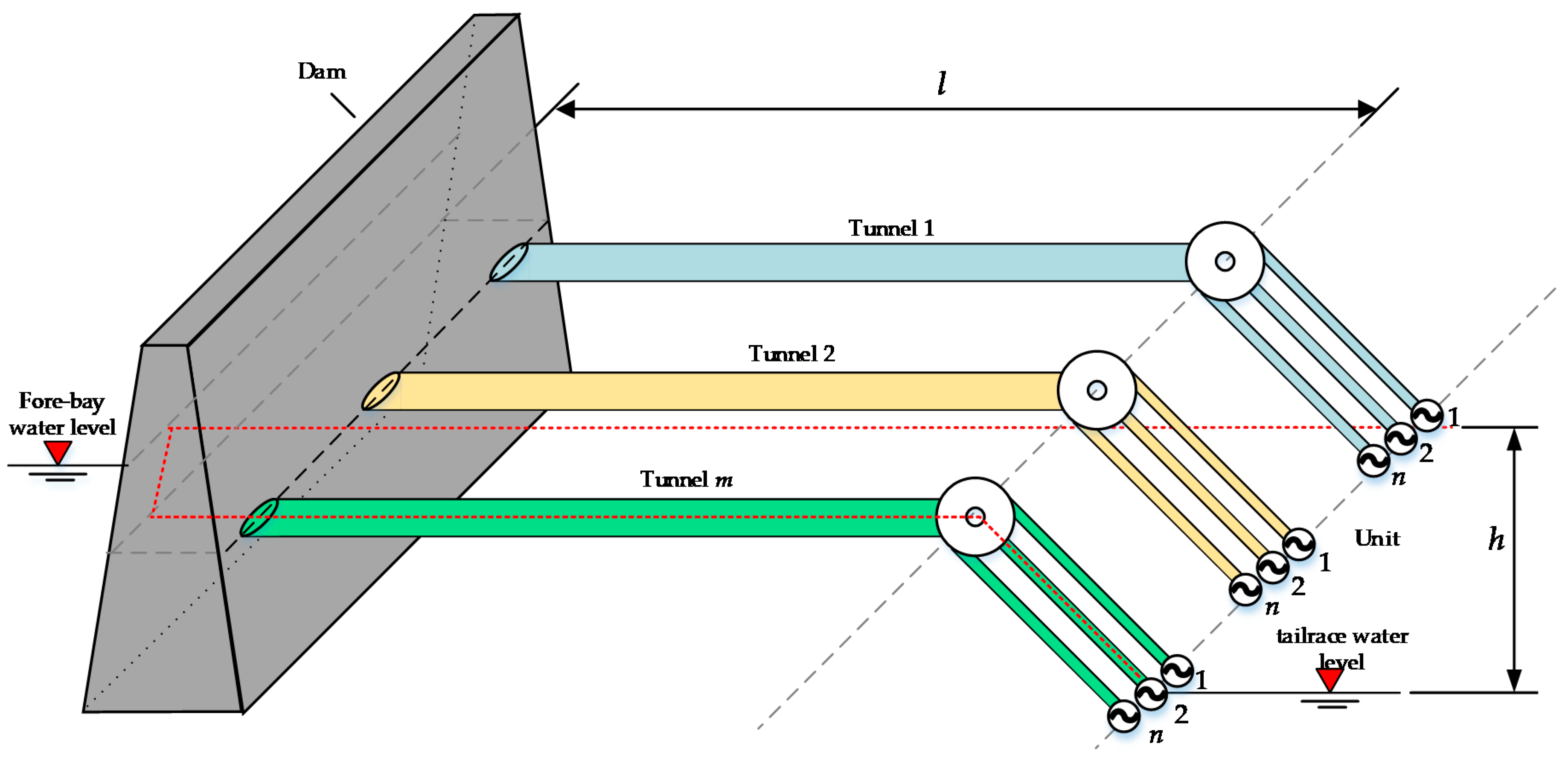
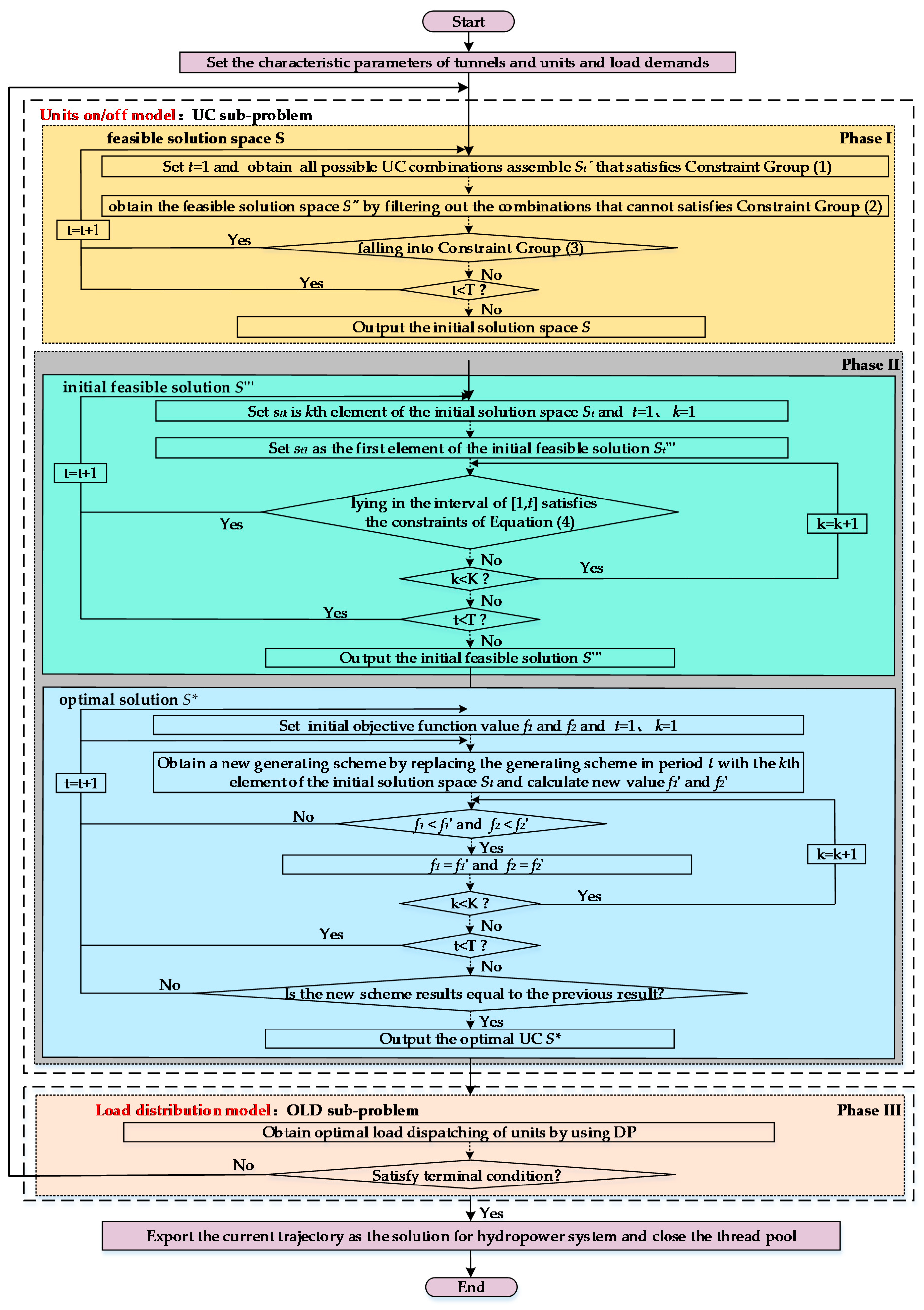
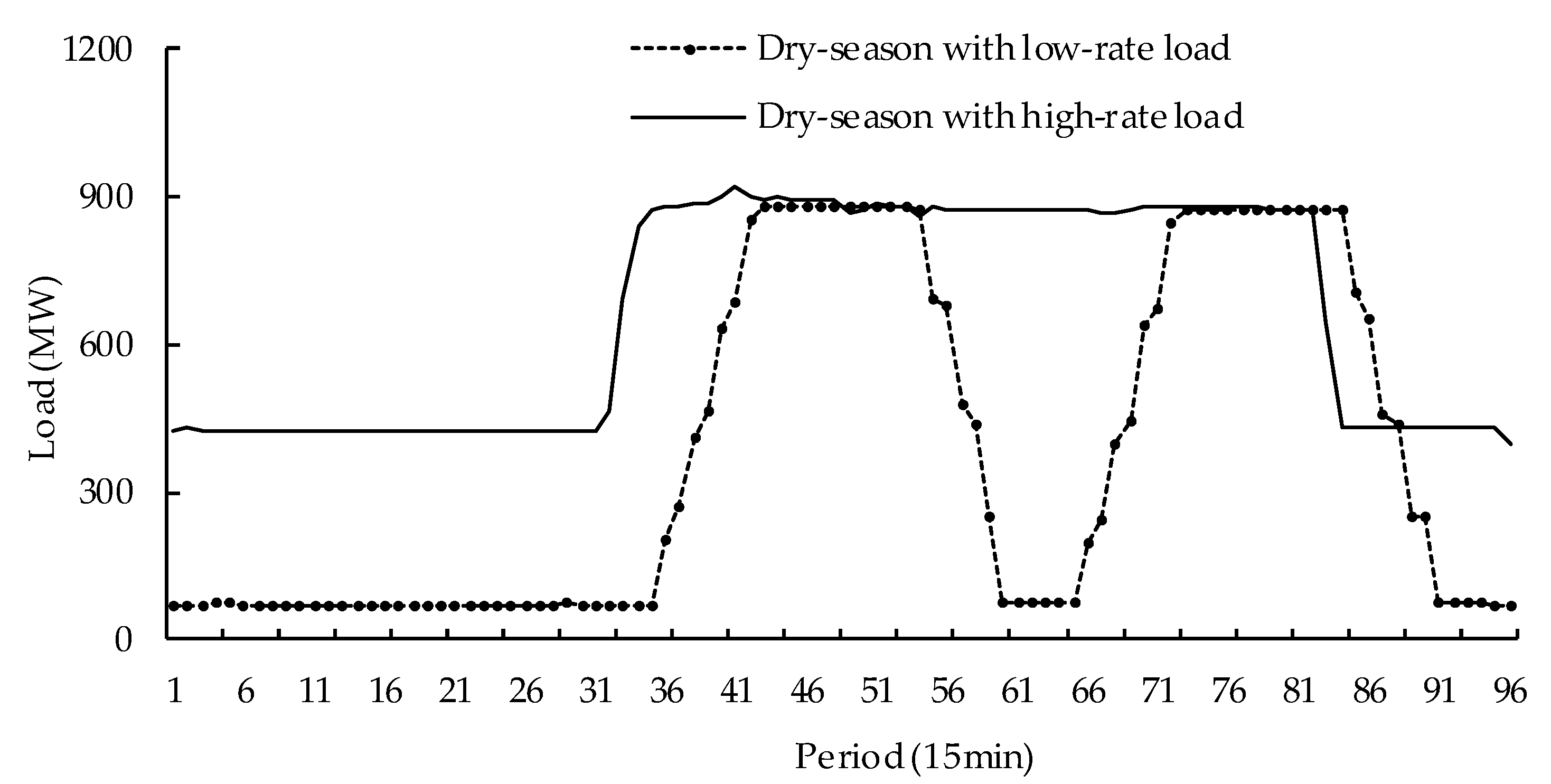
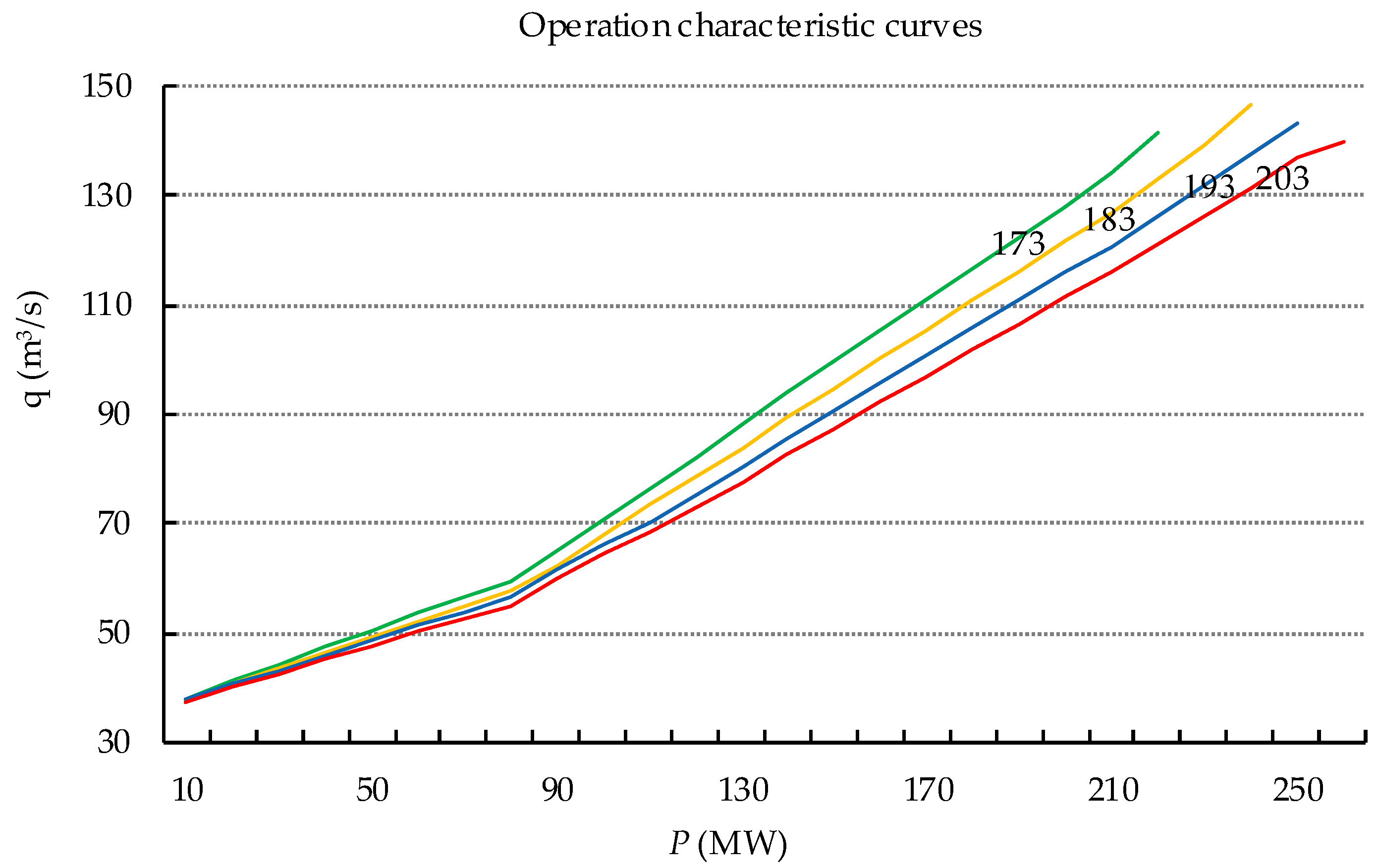
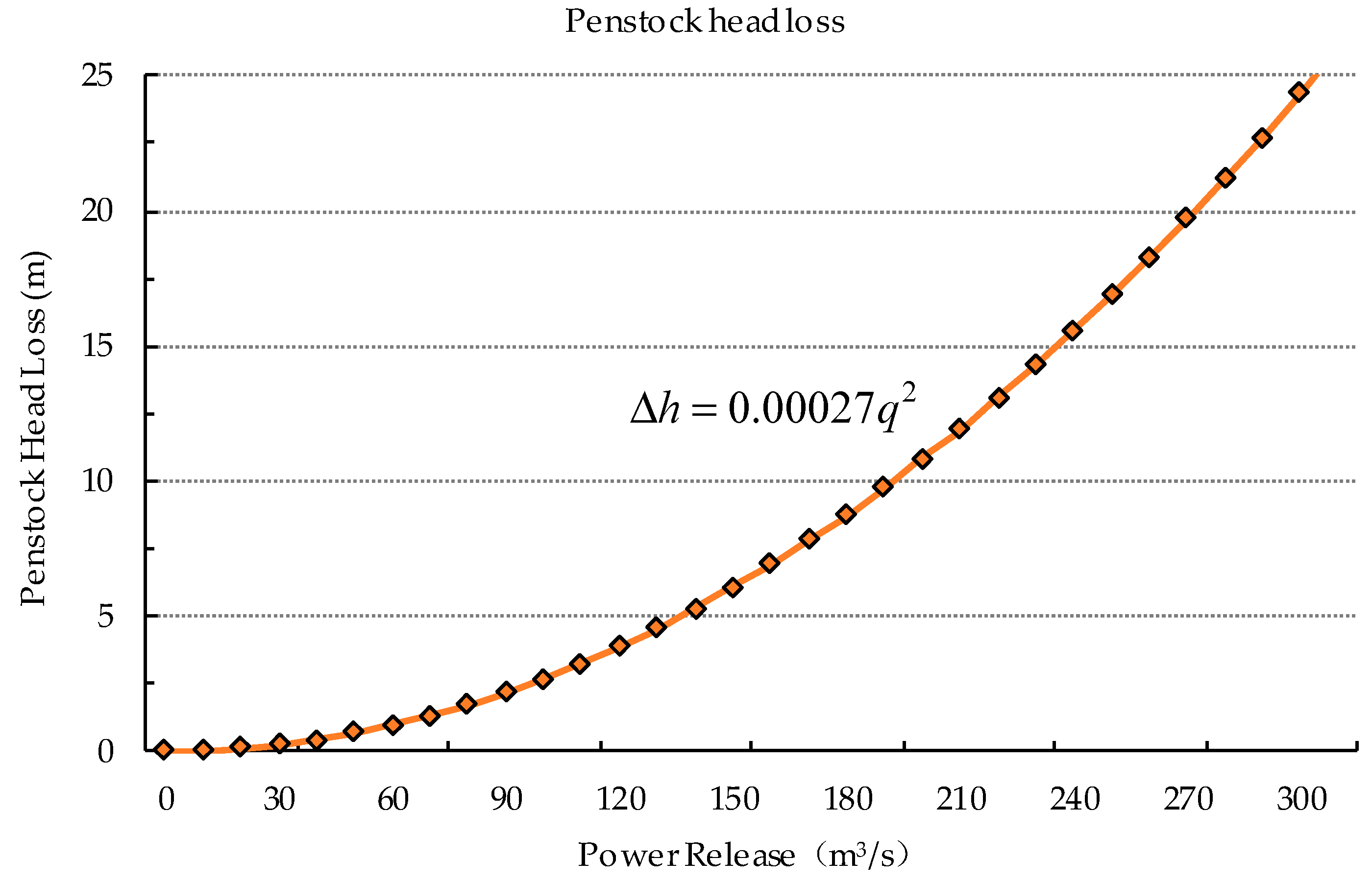
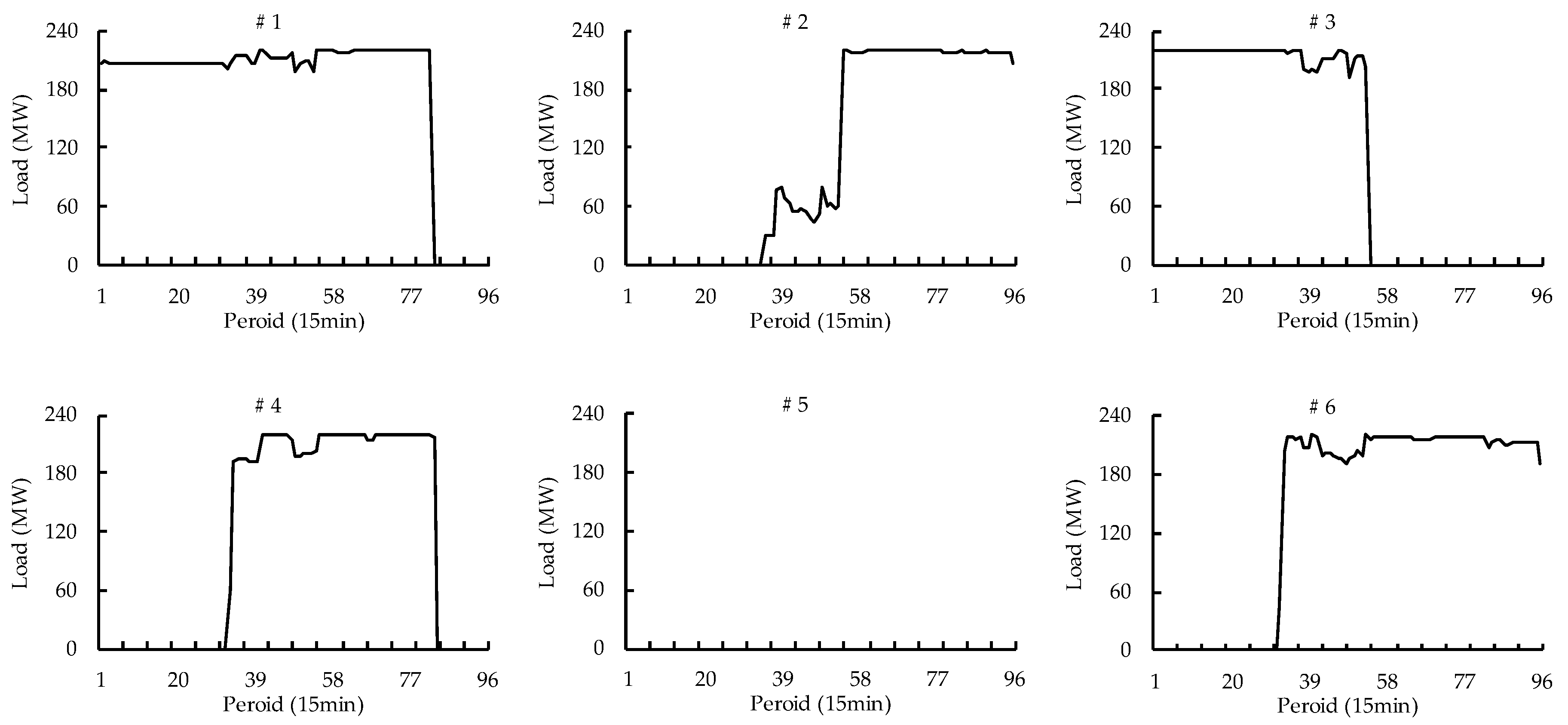
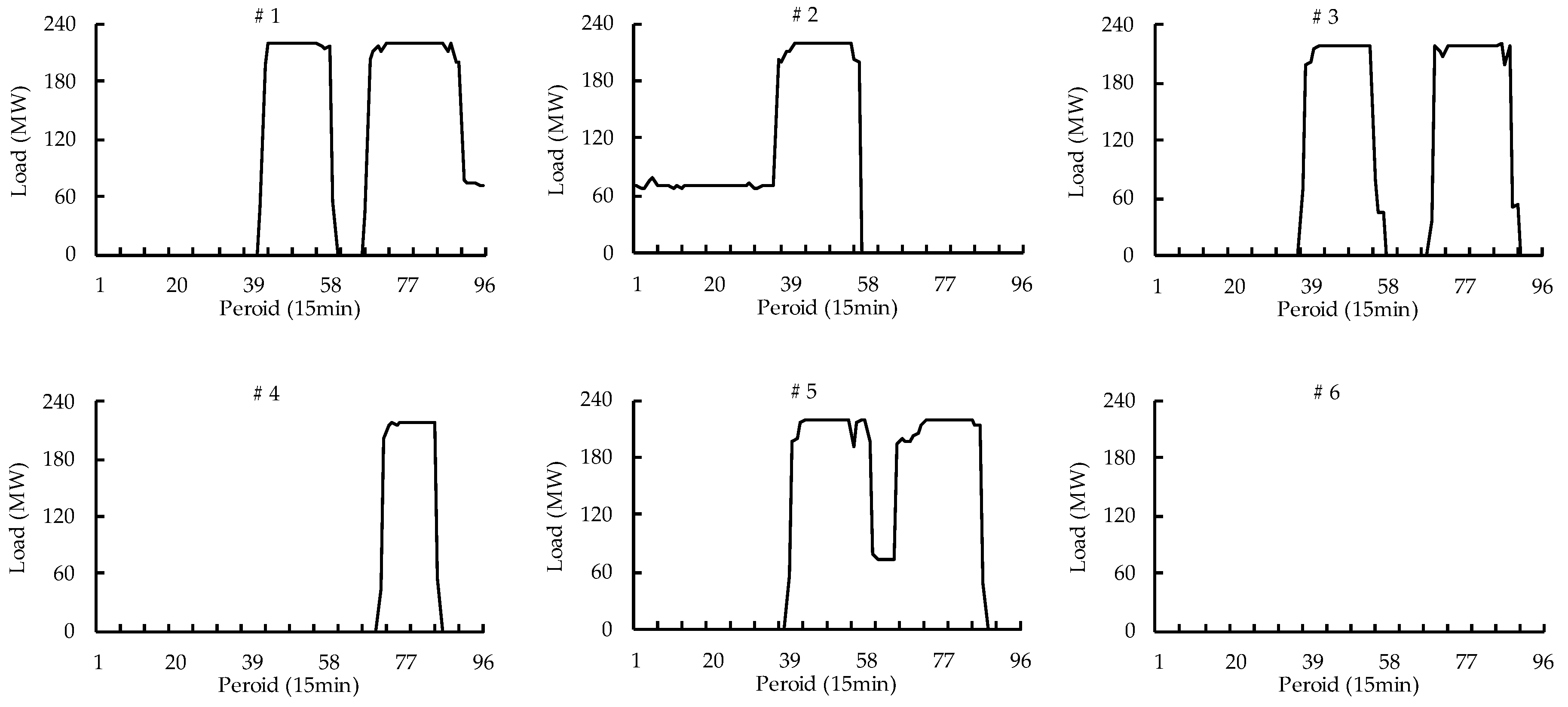
| Power Station | TSQII | Jinping II | Lubuge |
|---|---|---|---|
| Total installed capacity (MW) | 1320 | 4800 | 600 |
| Length of tunnel (km) | 9.77 | 16.67 | 9.38 |
| Average head (m) | 176 | 290 | 327.7 |
| Number of tunnels | 3 | 4 | 1 |
| Number of units | 2 | 2 | 3 |
| Item | Value |
|---|---|
| Maximum water head (m) | 645.00 |
| Minimum water head (m) | 637.00 |
| Units (capacity × number, MW) | 220.0 × 6 |
| Vibration zones (MW) | (80,190) |
| Startup/Shutdown water consumption (m3) | 1200 |
| Discrete step of water level (m) | 0.1 |
| Initial dam water level for dry season (m) | 642.18 |
| Duration of online/offline of units | 4 |
| Scheduling period (min) | 15 |
| Parameter A of penstock head loss | 2.7 × 10−4 |
| Tunnel | Unit | Turbine in One Tunnel | Two Turbines in One Tunnel | ||||||
|---|---|---|---|---|---|---|---|---|---|
| Load (MW) | Power Release (m3/s) | Head Loss (m) | Water Consumption Rate (m3/(kWh)) | Load (MW) | Power Release (m3/s) | Head Loss (m) | Water Consumption Rate (m3/(kWh)) | ||
| A | #1 | 217.6 | 123.8 | 4.14 | 2.05 | 217.6 | 123.8 | 4.14 | 2.05 |
| #2 | 0 | 0 | - | 0 | 0 | - | |||
| B | #3 | 0 | 0 | 4.14 | - | 217.5 | 134.8 | 19.62 | 2.23 |
| #4 | 217.5 | 123.8 | 2.05 | 217.5 | 134.8 | 2.23 | |||
| C | #5 | 0 | 0 | 4.14 | - | 0 | 0 | 0 | - |
| #6 | 217.5 | 123.8 | 2.05 | 0 | 0 | - | |||
| Total value | 652.6 | 371.4 | - | 2.05 | 652.6 | 393.4 | - | 2.17 | |
| Item | Dry Season with High-Rate Load | Dry Season with Low-Rate Load | ||
|---|---|---|---|---|
| Homogeneous Dispatch | TSM | Homogeneous Dispatch | TSM | |
| Number of fell into vibration zone | 51 | 0 | 34 | 0 |
| Water consumption (m3) | 3.75 × 107 | 2.70 × 107 | 2.93 × 107 | 2.01 × 107 |
| Period | Load (MW) | Tunnel A | Tunnel B | Tunnel C | Total | Duration of Unit | |||
|---|---|---|---|---|---|---|---|---|---|
| #1 | #2 | #3 | #4 | #5 | #6 | ||||
| 1 | 427.5 | 1 | 0 | 1 | 0 | 0 | 0 | 2 | 31 |
| 32 | 466.1 | 1 | 0 | 1 | 0 | 0 | 1 | 3 | 1 |
| 33 | 690.2 | 1 | 0 | 1 | 1 | 0 | 1 | 4 | 2 |
| 35 | 876.1 | 1 | 1 | 1 | 1 | 0 | 1 | 5 | 19 |
| 54 | 857.6 | 1 | 1 | 0 | 1 | 0 | 1 | 4 | 29 |
| 83 | 646.1 | 0 | 1 | 0 | 1 | 0 | 1 | 3 | 1 |
| 84 | 428.5 | 0 | 1 | 0 | 0 | 0 | 1 | 2 | 13 |
| 96 | 397.5 | 0 | 1 | 0 | 0 | 0 | 1 | 2 | |
| Period | Load (MW) | Tunnel A | Tunnel B | Tunnel C | Total | The Duration of Unit | |||
|---|---|---|---|---|---|---|---|---|---|
| #1 | #2 | #3 | #4 | #5 | #6 | ||||
| 1 | 71.3 | 0 | 1 | 0 | 0 | 0 | 0 | 1 | 36 |
| 37 | 268.6 | 0 | 1 | 1 | 0 | 0 | 0 | 2 | 2 |
| 39 | 466.4 | 0 | 1 | 1 | 0 | 1 | 0 | 3 | 2 |
| 41 | 685.3 | 1 | 1 | 1 | 0 | 1 | 0 | 4 | 16 |
| 57 | 479.9 | 1 | 0 | 1 | 0 | 1 | 0 | 3 | 1 |
| 58 | 436.5 | 1 | 0 | 0 | 0 | 1 | 0 | 2 | 2 |
| 60 | 78.3 | 0 | 0 | 0 | 0 | 1 | 0 | 1 | 7 |
| 67 | 243.1 | 1 | 0 | 0 | 0 | 1 | 0 | 2 | 2 |
| 69 | 444.3 | 1 | 0 | 1 | 0 | 1 | 0 | 3 | 2 |
| 71 | 670 | 1 | 0 | 1 | 1 | 1 | 0 | 4 | 15 |
| 86 | 652.6 | 1 | 0 | 1 | 0 | 1 | 0 | 3 | 2 |
| 88 | 438.5 | 1 | 0 | 1 | 0 | 0 | 0 | 2 | 3 |
| 91 | 77.6 | 1 | 0 | 0 | 0 | 0 | 0 | 1 | 6 |
| 96 | 72.3 | 1 | 0 | 0 | 0 | 0 | 0 | 1 | |
| Combinations of Generating Units | Capacity Combination/MW | Combined Vibration Zones/MW |
|---|---|---|
| One unit | 220 | (80,190) |
| Two units | 440 | (160,190) ∪ (300,380) |
| Three units | 660 | (520,570) |
| Four units | 880 | (740,760) |
| Five units | 1100 | Vibration-free Zone |
| Six units | 1320 | Vibration-free Zone |
© 2019 by the authors. Licensee MDPI, Basel, Switzerland. This article is an open access article distributed under the terms and conditions of the Creative Commons Attribution (CC BY) license (http://creativecommons.org/licenses/by/4.0/).
Share and Cite
Liao, S.; Zhao, H.; Li, G.; Liu, B. Short-Term Load Dispatching Method for a Diversion Hydropower Plant with Multiple Turbines in One Tunnel Using a Two-Stage Model. Energies 2019, 12, 1476. https://doi.org/10.3390/en12081476
Liao S, Zhao H, Li G, Liu B. Short-Term Load Dispatching Method for a Diversion Hydropower Plant with Multiple Turbines in One Tunnel Using a Two-Stage Model. Energies. 2019; 12(8):1476. https://doi.org/10.3390/en12081476
Chicago/Turabian StyleLiao, Shengli, Hongye Zhao, Gang Li, and Benxi Liu. 2019. "Short-Term Load Dispatching Method for a Diversion Hydropower Plant with Multiple Turbines in One Tunnel Using a Two-Stage Model" Energies 12, no. 8: 1476. https://doi.org/10.3390/en12081476





